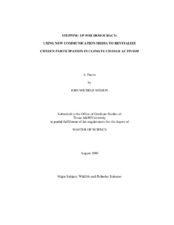| dc.description.abstract | Contemporary activists in the United States find it increasingly difficult to negotiate socio-political constraints to build a social movement. Those looking for relatively safe and effective venues for participation in and communication of dissent face oppression by the hegemonic power of the political right and, in the case of climate activism, anti-climate-science discourse. I use the case study of the climate action movement to explore how contemporary activists use new communication media technologies (hereafter new media) to establish and strengthen a movement. Even though climate change affects the daily lives of ordinary Americans, no U.S. policy exists to mitigate carbon emissions. New media offer the potential for new, safer venues for participation in and communication about social movements. I used empirical qualitative and critical methods to analyze the communication of climate change activism in Texas, USA.
I examined how Step It Up! 2007 (SIU) used new media to facilitate or constrain public participation in climate action. I used critical discourse analysis to examine information provided to citizens on the SIU website, and I attended the SIU event in San Antonio, Texas. I found SIU organizers successfully used new media to increase agitation and to shift power away from the federal government to the local grassroots level. I recommend activists use new media as a unifying tool, to provide a fragmented and apathetic citizenry with a message that can be used to affect change.
I conducted a critical rhetorical analysis of Working Film’s 2007 documentary on global warming, Everything’s Cool, as a means to suggest how, and in what ways, activists use new media to build a movement. I also hosted an activist screening. I examined how new media facilitate or constrain communication of movement messages. I found activists used the documentary and open source activism as a rhetorical exercise in agitation to refigure public understanding of climate science and attitudes toward U.S. climate change policy. Everything’s Cool positioned climate activism, and participating in the movement broadly, as accessible and acceptable, helping to rhetorically constitute a new kind of citizen activist, shifting power roles to a grassroots network of local leaders. | en |


